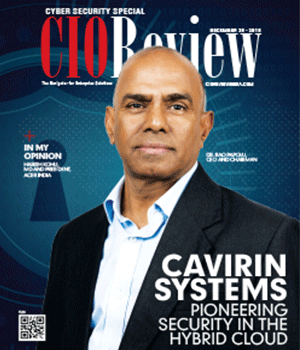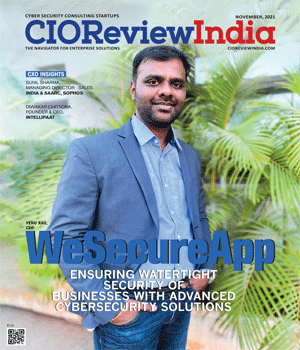
A Digital Journey - Cloud, Analytics, Mobile, Social and Security
Kapil Mahajan, CIO, Safexpress Pvt Ltd | Thursday, 10 January 2019, 14:16 IST
 Safexpress began its journey in 1997 with a mission of delivering logistics excellence to its customers and ensuring their success. Today, the firm hasfirmly entrenched itself as the 'Knowledge Leader' and 'Market Leader' of supply chain & logistics industry in India.
Safexpress began its journey in 1997 with a mission of delivering logistics excellence to its customers and ensuring their success. Today, the firm hasfirmly entrenched itself as the 'Knowledge Leader' and 'Market Leader' of supply chain & logistics industry in India.
It's a known fact now that the Cloud, Analytics, Mobile, Social and Security (CAMSS) have changed the way we interact with one another and how businesses need to redefine the way they liaison with their customers, to accelerate and fuel growth. The companies today both in India and globally are struggling to redefine and align their roadmaps around the CAMSS strategy and this journey is strikingly different for the fortune 500 companies as opposed to the SMB sector. The MNC’s have a mammoth task to consolidate their complex technical landscape which typically comprises of multiple applications and products from different vendors ranging and varying not only by line of business but also by locations spread across the globe, making their journey very complex and cumber some. The SMB sector on the other hand is not so hugely invested in myriad of technical stack and complex business processes and applications and hence can be nimbler in terms of their CAMSS journey. Let’s look at some of the strengths and challenges while implementing a roadmap around CAMSS.
Cloud:
The strengths that cloud computing brings to the organizations are three folds:
• Improves time-to-market to support Agile through standardization and automation
• Ease for developers to build new business capabilities
• Post-transition saves that could be potentially divested towards additional innovation spend
Given that in today’s world, market forces are characterized by headwinds that challenge growth, Cloud computing will help improve efficiency, drive revenue growth and expand innovation potential and can help achieve the four key imperatives that any industry and their leaders need to deliver on, which are:
• Enterprise focused around customer
• Increase flexibility and streamlined operations
• Competitive differentiation through accelerated innovation while managing the triple constraints (time, cost and scope)
• Optimized enterprise risk management
For any organization, the call to move to the cloud is not an easy one because the answer cannot be a simple matter of choice. Your cloud strategy should be a well thought approach detailed at the platform, application, security and interface level (internal and external) driven by needs guided by some key considerations like: Will the cloud move save me money in the long run? Will the cost of agility (measured in form of increased user experience or faster product launches etc) outweigh my increased monthly payouts? How will I ensure optimal performance? What is the effort and cost for cloud upskilling my workforce? What is my data security guidelines around SPI (Sensitive Personal Information) data? Approach for cloud platform selection and single vs multi cloud platform environment?
"One of the overlooked factors in the digital journey around Cloud, Analytics, Mobile and Social is Security"
In nutshell there is no denying the fact that organizations need to adopt a cloud strategy to succeed going forward but the process of laying down this roadmap needs to be well thought and planned for and there is no one size that fits all approach currently available in the market.
Analytics:
As organizations are moving into the connected world of IoT and IoE (Internet of Everything) there is a huge amount of data that the machines and humans are creating and organizations need to start making sense of this data. Big data platforms have become a necessity for most of the mid-sized and large companies where they can churn this huge amounts of structured and unstructured data into actionable incites that can help streamline their operations or substantially enhance the user experience or help uncover new business opportunities and models.
For organizations that are delving into the big data space for the first time the best practice is to first understand your analytics need and measure the results. Also to move analytics effort forward collaboration is essential since the right business focus and involvement will drive the optimal big data solution. The next critical step will involve managing the increasing amount of data and creating governance policies around it. Post this stage the state of the users and the data scientist in the company will determine the pace of advancement of your analytics competency along with its adoptability and use.
Mobile:
With mobile phones being all pervasive and number of mobile phone users on the globe expected to cross the 5 billion mark by 2019 these devices have literally become the first point of customer interface for any business. Since most of the interactions online have shifted from traditional desktops to handheld devices it’s imperative that organizations mobile strategy is a well laid out and integrated approach that seamlessly merges the business goals (Mission, Competitor analysis etc) with proposed mobile platform. Companies need to keep in mind that their mobile strategy should not be an extension of their online strategy.
Since Mobile is one of the key areas of CAMSS that is leading the digital transformation strategy today for most of the companies while shaping this strategy some of the key things to consider should include: Assessment and review of current state, building of a blueprint by testing multiple hypotheses and finally creating the overall roadmap.
Social:
Organizations today need to build 360° customer insight and for that there is a pressing need to club enterprise data with social media data to build a holistic view of customer, prospects and engagement. A lot of companies today are engaging in some form of social listening and monitoring to drive business outcomes centered around qualitatively improving exposure to social competition and to open-up brand social channels. Social analytics is being used by sales and marketing to leverage customer insights for influencer analysis, micro-segmentation, competitive and lead intelligence. Customer service is a strong contender since it could mine social media for customer service issues and use selfservice portals, community platforms and predictive analytics for better customer engagement and improve key CSAT metrics like response time/rate, resolution time/rate, channel effectiveness, churn reduction etc.
As organizations mature in this journey they would move from basic social listening towards analytically powered business transformation offerings which would eventually merge with their overall Analytics platform.
Security:
One of the overlooked factors in the digital journey around Cloud, Analytics, Mobile and Social is Security. With over 18 billion security events every day and more frequent and sophisticated breaches it is becoming necessary for organizations to have a robust security policy in place.
As companies are moving their systems and data to cloud and opening more and more channels that are directly integrating with their core systems any open window of threat can pose a big data risk that could potentially put the entire credibility of an organization at stake overnight. Depending on how deeply an organization is invested into the cloud and mobile space (IaaS , PaaS, SaaS etc) their security needs can get very complex not limited to just data security but include host of other aspects like infrastructure protection, identity and access management, advanced fraud detection and protection, application security etc.
Building a security roadmap could turn out to be time consuming and expensive proposition but a business necessity that cannot be ignored. Organizations are now building reference architectures with security component embedded in each layer of the technology stack to enforce multi-layer of protection in an advent of an attack.
Before security was an afterthought but off lately it is becoming the first thought that crosses your mind whether you’re a developer, manager or consumer since for an organization it could spell doom and for the customer it could potentially make his/her confidential data openly available to the entire world.
CIO Viewpoint
From VPNs to Zero Trust: The Transition to a...
By Shankar Venkatesan, Senior IT Leader, Avalon Technologies
The Cyber Security Spar in Integrating IT and...
By Vimal Goel, CIO, HPCL-Mittal Energy
Towards Cyber Resilience: A Data-Centric...
By Puneet Gupta, Vice President & Managing Director, NetApp India/SAARC
CXO Insights
Emerging Trends, Challenges & Future Prospects...
By Sujoy Brahmachari, CIO & CISO, Rosmerta Technologies
Exploring Data-First Security and Automation in...
By Maheswaran S, Country Manager - S.Asia, Varonis Systems
Securing IT-OT Converged Infrastructure




.jpg)
.jpg)
.jpg)







